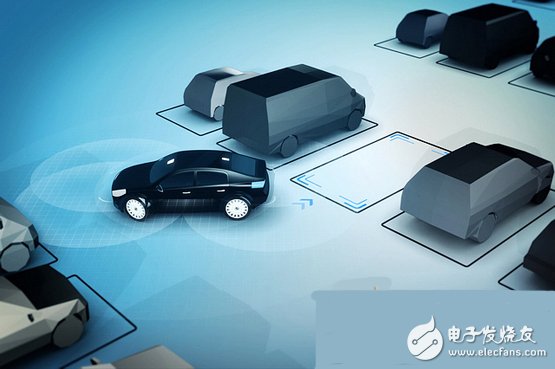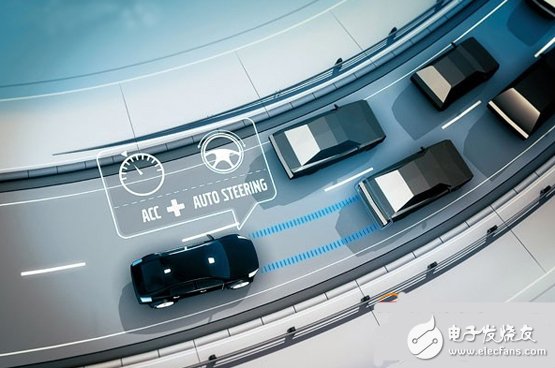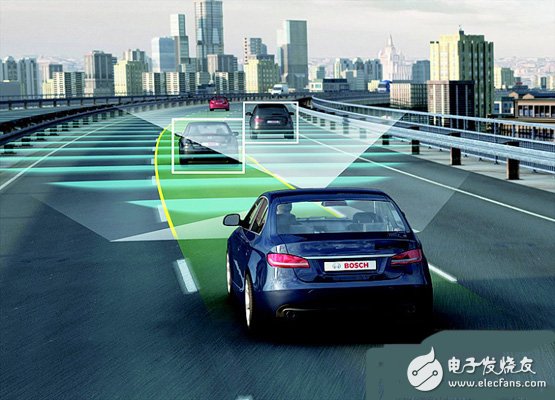The application of automation technology in industrial manufacturing has been relatively common, and it has contributed greatly to the manufacturing industry to improve efficiency and save manpower. With the development of technology, automation applications will become more and more extensive, and at the same time continue to penetrate into other fields, of which car driving automation is one of the applications.
When it comes to automated driving, everyone will think of driverless technology. Driverless technology has been listed as one of the major R&D projects by many car companies around the world. Many car companies, including Mercedes-Benz, BMW, Ford, etc., have carried out long-distance road tests with test vehicles matching unmanned technology, and plan to promote them in mass production models within a few years. While European and American auto companies are accelerating the application of driverless technology, Chinese automakers have begun to get involved in this field.
Unmanned driving is an important direction for the development of the future car. BYD, the “technical faction†in its own brand, is not far behind to start research and development. BYD has teamed up with the Research Institute of Science and Technology of Singapore to start research and development of autonomous driving technology. Let us look at the main application of automation technology in automobiles.
Easy parking into parking spaces with automatic parking technology
For many drivers, in-line parking is a painful experience. There is limited parking space in large cities, and it has become a must-have skill to drive cars into tight spaces. There are very few cases where the car is parked without any hassle. Parking can cause traffic jams, nervous exhaustion and bumpers being bumped. Fortunately, the development of technology provides a solution, which is the automatic parking function. With this technology, as long as you find an ideal parking place, you don't have to go back and forth, just click the button, sit and relax, everything else can be done automatically. The automatic parking technology is also suitable for active collision avoidance systems, and ultimately achieves automatic driving of the car.

Car manufacturers have developed cars that can park automatically because they are aware of the needs of consumers. In-line parking is usually the most worrying aspect of the driver's exam, and almost everyone will encounter such things in certain locations. Car owners in big cities may have to face this situation every day. If there is a car that can eliminate these troubles, then this car will definitely be very popular.
Different automatic parking systems use different methods to detect objects around the car. Some are equipped with sensors around the front and rear bumpers of the car, which can act as both a transmitter and a receiver. These sensors send a signal that is reflected back when the signal hits an obstacle around the body. The computer on the car then uses the time it takes to receive the signal to determine the location of the obstacle. Other systems use a camera or radar mounted on a bumper to detect obstacles. But the end result is the same: the car will detect the parked car, the size of the parking space and the distance from the roadside, and then drive the car into the parking space.
When the car moves to the side of the front car, the system will give the driver a signal telling him when he should stop. Then, the driver reverses the gear, releases the brakes a little, and starts to reverse. Then, the computer system on the car will take over the steering wheel. The computer turns the wheel through the power steering system and completely pours the car into the parking space. When the car falls far enough back, the system gives the driver another signal telling him that he should stop and change to the forward gear. The car moves forward and adjusts the wheels in place. Finally, the system gives the driver a signal telling him that the car has stopped.
The automatic parking system for cars has facilitated many newcomers who are not familiar with parking and parking, but the current automatic parking system for automobiles cannot be fully automated. The speed at which the car travels during parking is also controlled by the driver. Therefore, even with the assistance of the automatic parking system of the car, the driver can not be sloppy. With the development of technology in the future, I believe that in the near future, the automatic parking system for cars will surely come to the era of automatic control.
ACC active cruise automatic addition and subtraction speed
ACC active cruise system, this is a very convenient and easy to use system. Through the radar in front of the front of the vehicle, CC can automatically detect the distance from the vehicle in front. When the speed is above 30km, h, it can automatically maintain the set distance with the preceding vehicle. Allow the driver to save control of the throttle and brakes. This feature is currently available on some ACC active cruise systems. To put it simply, the ACC system adds a sensor that senses the distance to the preceding vehicle based on the original cruise control system. The computer automatically controls the throttle and brake system based on the feedback information from the sensor to achieve automatic acceleration and deceleration.

This system is very easy to use. During most of the test drive, I was experimenting with this system, which made my right foot a lot easier during the long driving process. Also, it is interesting. In conjunction with the automatic lane keeping system, cc can automatically travel along the selected lane by scanning the lane lines on both sides of the road, and automatically adjust the direction when the vehicle deviates from the lane, allowing the car to return to the lane. Therefore, if the AcC is turned on simultaneously with the automatic lane keeping system. The vehicle can basically travel on the highway in white. Very interesting, but the automatic lane keeping system will only help the driver to adjust the lane 3 times, then the driver will be alerted and the vehicle's control will be returned to the driver.
The ACC system includes a radar sensor, a digital signal processor, and a control module. The driver sets the desired speed. The system uses the low-power radar or infrared beam to get the exact position of the preceding vehicle. If the front vehicle is decelerated or a new target is detected, the system sends an execution signal to the engine or brake system to reduce the speed. Keep the vehicle and the front car at a safe distance. When the current road has no car, it will accelerate to the set speed, and the radar system will automatically monitor the next target. The active cruise control system replaces the driver to control the speed of the vehicle, avoiding the frequent cancellation and setting of the cruise control, making the cruise system suitable for more road conditions, providing the driver with a more relaxed driving style.
The radars currently applied to the ACC system mainly include single pulse radar, millimeter wave radar, laser radar, and infrared detection radar. The monopulse radar and the millimeter wave radar are all-weather radars, which can be applied to various weather conditions, and have the advantages of long detection range, large detection angle range, and many tracking targets. Lidar has higher requirements on the working environment and is sensitive to weather changes. The detection results in bad weather such as rain, snow, wind and sand are not ideal, the detection range is limited, and the tracking target is less, but its biggest advantage is that the detection accuracy is relatively high. And the price is low. Infrared detection is unstable in bad weather conditions, and the detection range is short, but the price is cheap.
Regardless of the type of radar used, ensuring real-time processing of radar signals is the first consideration. With the rapid development of automotive electronics technology, most of them now use DSP technology to process radar signals, and use CAN bus to output radar signals.
Automatic brake technology is in danger
According to relevant accident data, 50% of bicycle users in Europe die from traffic accidents that collide with cars, and the automatic emergency braking (AEB) system reduces the number of car rear-end accidents by at least a quarter and also reduces The number of casualties caused by traffic accidents. Starting in January 2014, the European New Car Assessment (Euro-NCAP) will rate the vehicle's active front collision warning/automatic braking technology for each car manufacturer and display the performance level of the relevant model in its rating form. .

The pedestrian and bicycle detection system with full automatic braking consists of a radar embedded in the grille, a camera mounted on the front of the interior mirror and a central control unit. The function of the radar is to detect the object and distance in front of the car, while the camera detects the type of object. Dual-mode radars provide a wider field of view, enabling early detection of pedestrians and cyclists. The HD camera detects the movement of pedestrians and bicycles. The central control unit continuously monitors and analyzes traffic conditions.
When the car is driving at high speed, the driver usually has enough time to take measures to prevent the rear-end accident (the distance between the cars is relatively long. Therefore, the inter-city emergency braking system is usually equipped with a front-mounted brake device. Anti-collision warning system, the system has an automatic braking function, the purpose is that once the driver does not respond to the warning signal, the car can stop in time.
Honda has pioneered the technology of emergency braking in the world at a speed of 60 kilometers per hour. The maximum speed that can avoid collisions has doubled in the past. Toyota plans to equip its cars in volume sales with automatic braking systems in 2015. Various car companies have adopted security as a means to establish a dominant position in a fiercely competitive market.
Fuji Heavy Industries also loaded the new automatic braking system "EyeSight" with a collision speed of 50 kilometers at the "Levorg", a wagon that was sold in May. Consumers can choose whether or not to load the system, and the estimated price is around 100,000 yen.
Lane offset technology is safe for driving
In foreign countries, the lane offset warning system has been equipped on many models. The foreign big brands that we are familiar with now basically have models with similar systems. In domestic cars, CC is the only model with this feature.

When the vehicle speed exceeds 65km/h, the CC evaluates whether the vehicle is offset by the camera module with the online controller, and displays the status through the control lights in the instrument cluster. If the vehicle deviates from the lane while driving and the driver does not respond in time, the system will automatically correct it according to the degree of deviation and send a warning signal to the driver. During the intervention turn, if the vehicle has left the traffic lane and the vehicle speed drops below 60km/h, the lane offset warning system alerts the driver through the vibration of the steering wheel to alert the driver to human intervention.
With the lane offset warning system, the steering wheel automatically corrects the direction as long as it does not encounter a large curve, so that the vehicle keeps driving in the lane without deviation, and the driver is not required to frequently operate the steering wheel. At the same time, due to the heating function of the digital camera used by CC, the reliability of the LaneAssit lane offset warning system in rain and snow weather is greatly enhanced. Since the working principle of the system is based on the evaluation of the camera module, if the road condition is not good and the road with unclear bands is separated, the system function will be greatly affected.
Wire-controlled technology makes driving easier in the future
The wire control technology was developed from Fly-By-Wire for aircraft driving control. The technology uses sensors to transmit driver input signals to the central processor, and sends signals to the appropriate actuators through the central processor's control logic to perform driver-related operations. This can replace the traditional mechanical structure to achieve electronic remote control of various sports of the car.
The wire control technology has been continuously developed for more than 20 years, but consumers think that the wire control technology is still immature, there is no mechanical transmission reliable, and the luxury car users feel that the use of the wire control system is not as good as the traditional mechanical system, so this technology Popularity has been greatly hindered. Once Toyota was caught in a lawsuit due to a line-controlled throttle failure.
Robert Beaver, chief engineer of the brake manufacturer ConTInental Teves, said that consumers are now able to accept the technology, which will play a positive role in the development of new solutions. In the past few years, mainland and other component suppliers are working hard to develop various types of automotive electronic wire control technology. In recent years, hot-steel electric vehicles and hybrid vehicles have adopted electronic remote-controlled shifting gearboxes, including Toyota Prius and Lexus CT200h. Systems based on electronic remote control technology can use fewer component counts. Simplify the process of car manufacturing. In theory, it should also simplify the design of the car, which means that the overall design cost is reduced.
Aluminum Frame LV 3PH Asynchronous Motor
Aluminum Frame Lv 3Ph Asynchronous Motor,Three-Phase Asynchronous Motor,3 Phase Asynchronous Induction Motor,Aluminum Frame Three Induction Motor
Yizheng Beide Material Co., Ltd. , https://www.beidevendor.com